No 5 - 2014
Acute and chronic hepatitis B 2012 and 2013
Acute and chronic hepatitis B 2012 and 2013
Acute Hepatitis B 2012
2012 saw 25 notifications of acute hepatitis B, including 21 men, Table 1. The median age was 32 years (range 17-71 years). A total of 22 (88%) were Danish, and three (12%) were immigrants. Among the 22 Danish infectees, 16 were infected in Denmark. Two were infected in Thailand and one in Argentina, whereas the country of infection was not stated for three persons. Among the three immigrants, two were infected in Denmark and one in Uganda.
Nine were infected by heterosexual contact, five by homosexual contact. For two homosexually infected men, information on complete or partial hepatitis B vaccination was given. Five had been infected due to drug use and one via a non-occupational needle stick injury. In five cases the source of infection was unknown.
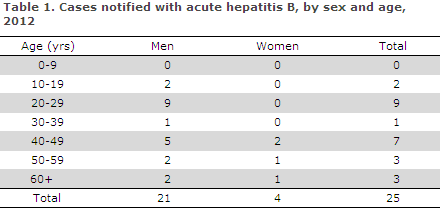
Acute hepatitis B 2013
2013 saw 19 notifications of acute hepatitis B, including 12 men, Table 2. The median age was 40 years (range 10-69 years). A total of 15 (79%) were Danish and four (21%) were immigrants. Among the 15 Danish infectees, 13 were infected in Denmark, one in Spain and in one case the country of infection was not stated. Of the four immigrants, two were infected in Denmark, one in Afghanistan and one in Thailand.
Ten were infected via heterosexual contact, three via homosexual contact and two via drug use. In four cases, the source of infection was unknown, one of whom was a dialysis patient. The latter case is currently being investigated.
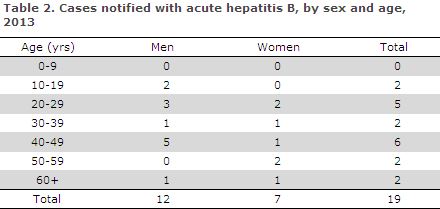
Chronic hepatitis B 2012
In 2012, a total of 276 cases of chronic hepatitis B were notified, Table 3.
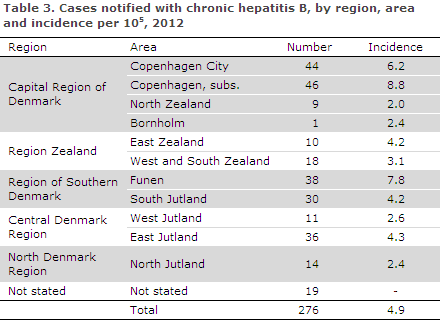
A total of 174 (63%) were women, Table 4, including 91 (52%) childbearing women.
The median age was 34 years (range 2-78 years). The majority, 257 (93%) were of foreign origin, including 13 second-generation immigrants, whereas 19 (7%) were of Danish origin.
The notified persons of foreign origin were from a total of 55 nationalities, including 108 persons (42%) from South-East Asia. For a total of 20 immigrants, no information on the year of entry into Denmark was provided. Among the remaining 224, 29 (13%) had entered Denmark in 2012 and 22 (10%) in 2011. The remaining 173 (77%) had entered Denmark sometime in the 1973-2010 period.
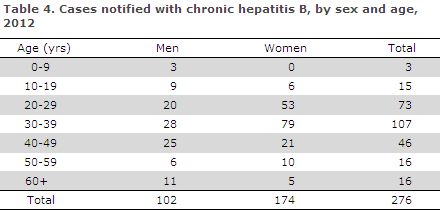
The most frequent route of infection was mother-to-child infection (88% of the notifications in which a route of infection was stated), Table 5.
Nearly all mother-to-child infectees were of foreign origin (99%). For two persons of Danish origin, mother-to-child infection in Denmark was stated; both had been infected prior to the introduction of screening of pregnant women, EPI-NEWS 25-32/05. Eleven persons born by foreign parents were infected at birth in Denmark. This group counted two children who had received hepatitis B vaccination; one had received the full vaccination programme, the other was partly vaccinated.
The remaining nine were born prior to the introduction of routine hepatitis B screening for pregnant women. A total of 19 persons were infected due to sexual contact, including six persons in Denmark, five heterosexually infected persons and one homosexually infected person. Seven persons were infected via drug use, all in Denmark. There were six notified cases of nosocomial infection, all of whom were infected abroad.
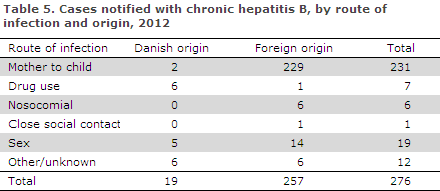
Chronic hepatitis B 2013
In 2013, a total of 236 cases of chronic hepatitis B were notified, Table 6.

A total of 139 (59%) were women, Table 7, including 68 (49%) pregnant women.
The median age was 35 years (range 5-88 years). The majority, 208 (88%), were of foreign origin, including seven second-generation immigrants, whereas 28 (12%) were of Danish origin. The notified persons of foreign origin were from a total of 53 nationalities, including 84 persons (40%) from South-East Asia.
For a total of 16 immigrants, no information on year of entry into Denmark was provided. Among the remaining 185, 27 (15%) had entered Denmark in 2013 and 20 (11%) in 2012. The remaining 138 (75%) had entered Denmark sometime in the 1971-2011 period.
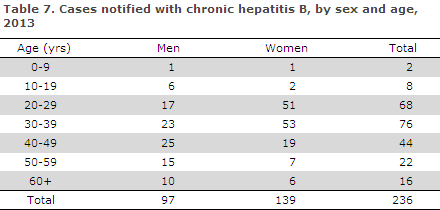
The most frequent route of infection was mother-to-child infection (84% of the notifications in which a route of infection was stated), Table 8.
Nearly all mother-to-child infectees were infected by mothers of foreign origin (97%). Four persons, who were registered as Danes, had a Danish father and a South-East Asian mother, and were infected at birth in Denmark prior to the introduction of screening of pregnant women, EPI-NEWS 25-32/05.
Six persons born by foreign parents were infected at birth in Denmark. This group included a child who was fully vaccinated. The remaining five were born prior to the introduction of routine screening of pregnant women. A second-generation immigrant who tested positive for hepatitis B as part of the pregnancy screening had been vaccinated as an adult without having been tested first.
Eleven persons were infected due to sexual contact, including four persons in Denmark, one heterosexually infected and three homosexually infected. Seven persons were infected via drug use, including five in Denmark. There were nine notified cases of nosocomial infection, all of whom were infected abroad. Two persons were notified as having been infected by close social contact.
One of these was a Danish adopted child who had been infected at an orphanage many years earlier. The other was an immigrant from China who was infected before arriving to Denmark. One immigrant was infected in connection with a needle stick injury in Romania.
For 52 persons, no probable source of infection was provided. The majority (40, 77%) were immigrants from high- endemic countries, who had been infected prior to their arrival to Denmark. Eleven were Danes aged 52-88 years, all of whom were notified as having been infected in Denmark or for whom a country of infection was not stated. One second-generation immigrant was notified as having been infected in Denmark.
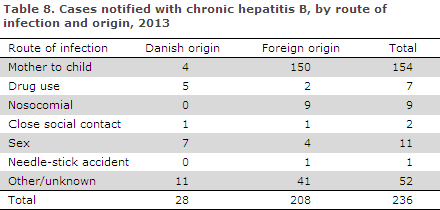
Commentary
The number of persons notified with acute hepatitis B infection in 2012 and 2013 remained in line with the low level observed in recent years, Figure 1. The majority were infected in Denmark either via sexual contact of due to drug use. A small number of these persons were infected via sexual contact while travelling abroad.
In most of the cases caused by infection through sexual contact, there was no information on the source of infection, but in a limited number of cases, the source of infection was stated to be associated with drug use environments. Sexual infection with hepatitis B may be prevented by offering free vaccination to persons who have sexual contact with hepatitis B carriers.
Young persons who have sex partners with a non-Danish ethnic background should be informed of this so that they can take steps to become vaccinated free of charge if their partner has chronic hepatitis B. Physicians should be attentive to this group as these persons are generally unaware that they are at risk of hepatitis B infection.
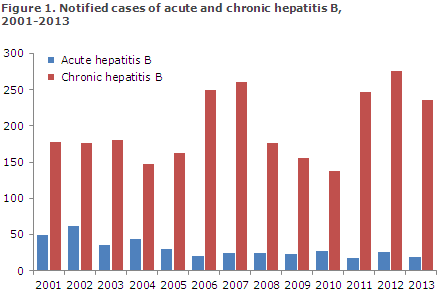
The number of persons notified with chronic hepatitis B in 2012 and 2013 was in line with the level observed in 2011 and 2006-07. In these periods, the SSI sent out reminders for notifications when the pregnancy screening reported cases which had not previously been notified, Figure 1.
Hepatitis B acquired at birth remains the most frequent cause of chronic hepatitis B, and in Denmark it mainly affects immigrants from high-endemic areas. After the introduction of general screening of pregnant women, EPI-NEWS 41/05, the number of children infected with hepatitis B at birth in Denmark has dropped considerably, EPI-NEWS 22/13. If a child who is born by a woman who is a hepatitis B carrier is vaccinated at birth and subsequently at 1, 2 and 12 months of age, it can generally achieve protection against the infection.
In 2013, screening was introduced for these children after they have completed the vaccination programme, EPI-NEWS 11/13. At present, this screening has not been evaluated, but a number of children were notified after testing positive to HBsAg despite vaccination, including two children notified in 2012 and one child notified in 2013.
Pregnant women with a high level of hepatitis B DNA (viral load) have an increased risk of infecting their child before giving birth compared to women who have a low level of hepatitis B DNA. Work-up and treatment of pregnant women who have hepatitis B is a specialist task, and it is essential that women who test HBsAg positive during their pregnancy are immediately referred to a specialist department for further assessment, whether they have symptoms or not. If a high level of hepatitis B DNA is found, these women may be treated during their pregnancy which will reduce the risk of intra-uterine transmission of infection.
In 2012, two homosexually infected men were notified; they had been infected despite vaccination. It was not stated if the two men were also HIV positive. HIV positive’s reaction to several vaccines is poorer than normal; this includes their reaction to hepatitis B vaccination. Therefore, it is essential that HIV positive persons are tested for hepatitis B antibodies after the vaccination series has been completed. This is described in the Danish Health and Medicines Authority's guideline on prevention of HIV and hepatitis B and C from 2013, which is available (in Danish) at www.sst.dk.
A woman of non-Danish origin was found to be HBsAg positive during her pregnancy even though she had been vaccinated ten years earlier. It is recommended that persons from areas where hepatitis B is highly endemic are tested before being vaccinated as vaccination of an already infected person may lead to a false sense of protection and cause further spreading of the infection.
More than three in every four notified person who was born abroad were notified more than two years after having entered Denmark. Some of these persons were probably diagnosed earlier, but were not notified. However, some will have been diagnosed several years after having immigrated to Denmark. During this interval, this group will not only unknowingly have been a possible source of infection, it will also have missed the opportunity of control and treatment of their condition.
(S. Cowan, Department of Infectious Disease Epidemiology)
Link to previous issues of EPI-NEWS
29 January 2014